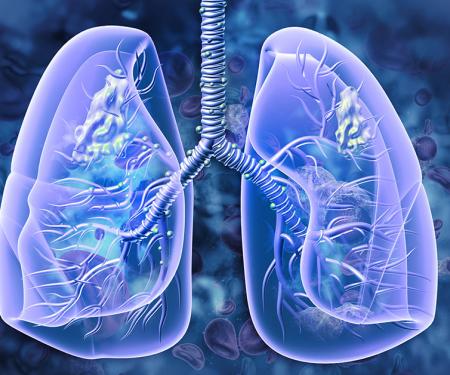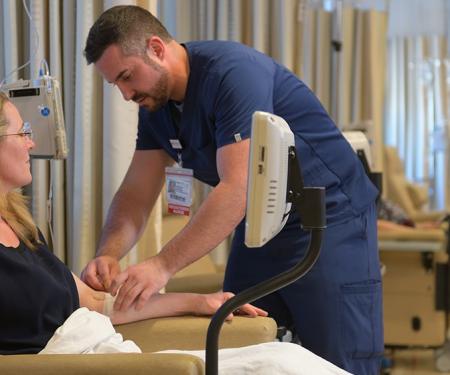If you’ve had chemotherapy, you have had a form of systemic therapy. Chemotherapy and other forms of systemic therapy are powerful treatments that are designed to reach every part of your body in order to target cancer cells wherever they may be.
Systemic therapies will vary according to the type of cancer you have. Your treating physician will develop a recommendation after reviewing your case.
Systemic Therapies for Non-Small Cell Lung Cancer
Chemotherapy
These are drugs that can be taken by mouth or injected into a vein, muscle, or another part of the body. The way the chemotherapy is given depends on the type and stage of the cancer being treated. The drugs enter the bloodstream and can reach cancer cells throughout the body.
About 50% of lung cancer patients are initially treated with chemotherapy to help cure, control, or ease the symptoms of lung cancer.
Chemotherapy and radiation therapy are often given together as the main treatment for lung cancer, depending on the stage of the cancer. Chemotherapy is sometimes given after surgery if the patient has a more advanced tumor. The side effects of chemotherapy can be minimized with the latest supportive treatments.
Targeted therapy
This therapy uses drugs or other substances to attack the processes that cancer cells use to grow. This approach usually causes less harm to normal cells than chemotherapy or radiation therapy do.
The most common targeted therapy uses drugs called small-molecule tyrosine kinase inhibitors. These substances work inside the cancer cells. They block the action of specific cancer enzymes, which may be too active or found at high levels in some types of cancer cells. Blocking these enzymes may help keep cancer cells from growing. Small-molecule tyrosine kinase inhibitors may be used with other anticancer drugs to lower the risk of the lung cancer returning.
For a small number of patients who have a specific gene mutation, another targeted therapy treatment—angiogenesis drugs—attack the blood vessels that supply the cancer with nutrition.
Monoclonal antibody therapy
This therapy uses antibodies made in the laboratory from a single type of immune system cell. Antibodies can identify substances on cancer cells or normal substances in the blood or tissues that may help cancer cells grow. Then, the antibodies attach to the substances and kill the cancer cells, block their growth, or keep them from spreading. Monoclonal antibodies are given by infusion. They may be used alone or to carry drugs, toxins, or radioactive material directly to cancer cells.
Immunotherapy
Immunotherapy is the groundbreaking use of drugs, therapeutic vaccines, viruses, antibodies, and cell-based techniques. This method activates the body’s own immune system to identify certain kinds of cancer cells and slow their growth. Fox Chase clinical researchers are currently investigating a variety of immunotherapy approaches to determine which patients might benefit from treatment for non-small cell lung cancer and other cancers.
Systemic Therapies for Small Cell Lung Cancer
Patients with small cell lung cancer typically receive chemotherapy because their cancer has often spread by the time it is diagnosed. Treatments, such as surgery or radiation, reach some cancer cells, but not all of them. Chemotherapy is able to kill cancer cells throughout the body. Sometimes when chemotherapy and radiation are given together, it is then followed by immunotherapy.
If your cancer grows worse during treatment, or if your treatment concludes but the cancer returns within 6 months, your physician might recommend trying another chemotherapy drug. In that case, most physicians prefer using a single, different drug to help reduce side effects such as vomiting, nausea, or fatigue. Another option is to take part in a clinical trial of newer treatments under investigation.
“I saw a patient who had an earlier-stage cancer that had been treated with surgery or radiation, and cured. Then, it recurred. That can mean a life-ending event. But it only recurred in one place, a lymph node above her clavicle, and we treated her with chemotherapy and radiation. She was youngish—in her 50s—and in better health and could handle it. Had she gone to other places, I’m not sure they would have treated her. Frankly, she shouldn’t be here. For now, she’s disease-free.”
— Joseph Treat, MD, medical oncologist and lung cancer specialist


